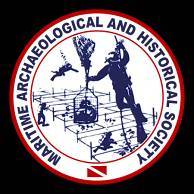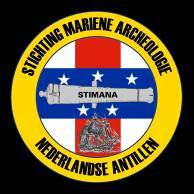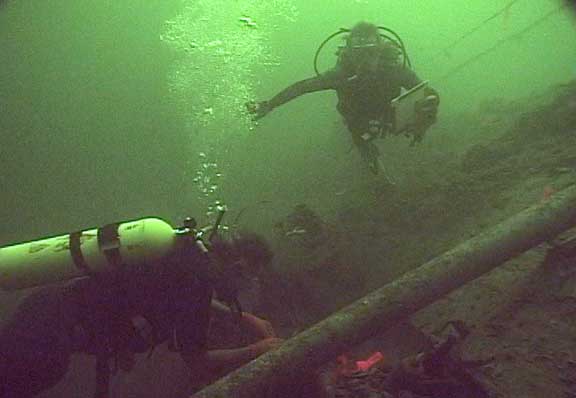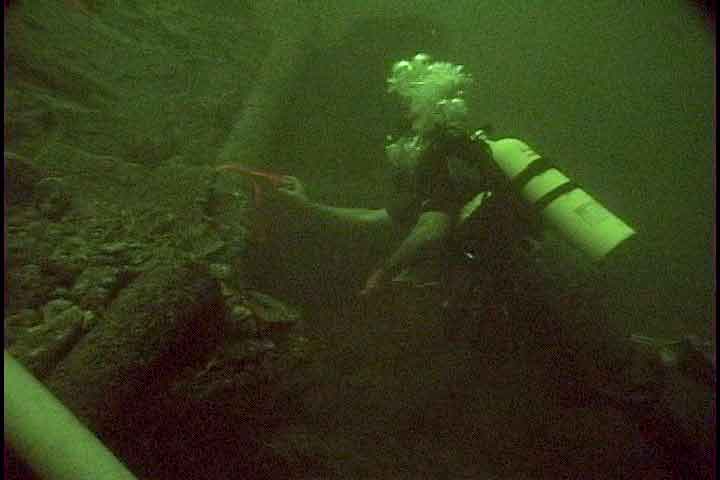
|
MAHS
in the Netherlands Antilles
|

|
 The Mediator was a
metal-hulled British steamship that was owned and operated by the Thomas & James Harrison Shipping Line.
The remains of the vessel lie relatively intact at the bottom of the Willenstad harbor where it sank after
colliding with the Thuringia, a vessel of the Hamburg-Amerika Line. Prior to arriving in Curaçao,
the Mediator had made stops in Barbados, Trinidad, and several ports along the Venezuelan coast.
Cargo transfers had been made at each of these ports.
The Mediator was a
metal-hulled British steamship that was owned and operated by the Thomas & James Harrison Shipping Line.
The remains of the vessel lie relatively intact at the bottom of the Willenstad harbor where it sank after
colliding with the Thuringia, a vessel of the Hamburg-Amerika Line. Prior to arriving in Curaçao,
the Mediator had made stops in Barbados, Trinidad, and several ports along the Venezuelan coast.
Cargo transfers had been made at each of these ports.
No surviving manifest has been located and reports
of the incident state merely that the Mediator was carrying "fine goods"and coal. Following the collision,
the vessel sank quickly, leaving only time to remove a portion of the cargo that had been loaded in Curaçao.
|
The only descriptions we have of the ship are
a contemporary newspaper article that includes the silhouette drawing shown above, and brief, hand-written notes
from the Harrison archives. Both sources indicate that the ship was built in Liverpool and was originally
known as Dalia. She displaced 2,011 tons and was 91.5 meters (300 ft) long, 10.6 meters (34.8 ft)
wide, and 7.7 meters (25.3 ft) deep.
|
 Over the course of several years, divers from MAHS and STIMANA have
cleared and mapped portions of the wreck. The forward cargo hold has been identified and under supervision from the STIMANA archaeologists,
excavation was initiated both there and amidships to document any remaining evidence of the cargo. Over the course of several years, divers from MAHS and STIMANA have
cleared and mapped portions of the wreck. The forward cargo hold has been identified and under supervision from the STIMANA archaeologists,
excavation was initiated both there and amidships to document any remaining evidence of the cargo.
Deck features and surviving portions of
the gunwhales have been mapped using baseline trialteration. The starboard side of the hull, which faces the modern
harbor channel, fairs out over a distance of about 10 meters from the bow. At that point a large gap occurs in the hull that
appears to be the result of damage from the collision that sank the vessel.
A large amount of debris covers portions
of the wreck. Some of the debris consists of the original superstructure of the ship. In the period immediately
following the accident, the funnel, masts, derricks, and other high-standing equipment and rigging would have posed a
threat to shipping. They were probably removed with grapples and draglines. The process would have caused
extensive damage to the deck and features attached to it, damage that is consistent with what is visible today.
|
 Coral rubble and dredging spoil litter
the wreck, the latter generated in large part by construction and later renovation of the wall of the modern quay nearby.
The harbor bottom is steeply sloped in the area in which the Mediator lies, extending from the base of the
quay at a depth of about 9 meters (30 feet) to the harbor channel that is more than 24 meters (80 feet) deep. Coral rubble and dredging spoil litter
the wreck, the latter generated in large part by construction and later renovation of the wall of the modern quay nearby.
The harbor bottom is steeply sloped in the area in which the Mediator lies, extending from the base of the
quay at a depth of about 9 meters (30 feet) to the harbor channel that is more than 24 meters (80 feet) deep.
Measurements have been taken of
the angle of the Mediator‘s deck at various points where it is visible. The angle varies from about 20
degrees to more than 45 degress, suggesting that the ship is twisted along its length, either as a result of striking
the harbor bottom or from the force of the massive debris that is creeping slowly downslpoe towards the channel and is
pressing against the port side of the hull.
|
|


 The Mediator was a
metal-hulled British steamship that was owned and operated by the Thomas & James Harrison Shipping Line.
The remains of the vessel lie relatively intact at the bottom of the Willenstad harbor where it sank after
colliding with the Thuringia, a vessel of the Hamburg-Amerika Line. Prior to arriving in Curaçao,
the Mediator had made stops in Barbados, Trinidad, and several ports along the Venezuelan coast.
Cargo transfers had been made at each of these ports.
The Mediator was a
metal-hulled British steamship that was owned and operated by the Thomas & James Harrison Shipping Line.
The remains of the vessel lie relatively intact at the bottom of the Willenstad harbor where it sank after
colliding with the Thuringia, a vessel of the Hamburg-Amerika Line. Prior to arriving in Curaçao,
the Mediator had made stops in Barbados, Trinidad, and several ports along the Venezuelan coast.
Cargo transfers had been made at each of these ports.  Over the course of several years, divers from MAHS and STIMANA have
cleared and mapped portions of the wreck. The forward cargo hold has been identified and under supervision from the STIMANA archaeologists,
excavation was initiated both there and amidships to document any remaining evidence of the cargo.
Over the course of several years, divers from MAHS and STIMANA have
cleared and mapped portions of the wreck. The forward cargo hold has been identified and under supervision from the STIMANA archaeologists,
excavation was initiated both there and amidships to document any remaining evidence of the cargo.
 Coral rubble and dredging spoil litter
the wreck, the latter generated in large part by construction and later renovation of the wall of the modern quay nearby.
The harbor bottom is steeply sloped in the area in which the Mediator lies, extending from the base of the
quay at a depth of about 9 meters (30 feet) to the harbor channel that is more than 24 meters (80 feet) deep.
Coral rubble and dredging spoil litter
the wreck, the latter generated in large part by construction and later renovation of the wall of the modern quay nearby.
The harbor bottom is steeply sloped in the area in which the Mediator lies, extending from the base of the
quay at a depth of about 9 meters (30 feet) to the harbor channel that is more than 24 meters (80 feet) deep.